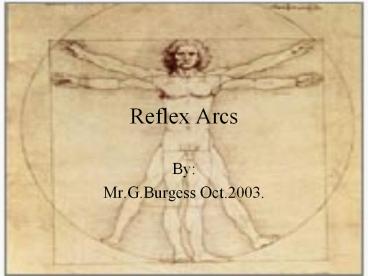Reflex Arcs - PowerPoint PPT Presentation
1 / 10
Title: Reflex Arcs
1
Reflex Arcs
- By
- Mr.G.Burgess Oct.2003.
2
Reflex Arc
- A reflex arc is the transmission of a stimulus
from a sensory cell to the spinal cord to a
muscle.
Fig.1 http//web.ukonline.co.uk/webwise/spinneret/
humans/recodr.htm, October 2003.
3
Types of Neurons
- Three types of neurons are used for the reflex
- Sensory neuron (afferent pathway) taste, touch,
see, hear - interneuron relays messages from sensory to
motor neurons. - Motor Neurons (efferent pathway) sends messages
to muscles so that they contract.
4
Sending Messages
- Messages are electrochemical impulses that are
send through neurons by depolarizing them and
making an action potential. - Neurons that are not sending messages are
polarized they have a greater concentration of
Na outside the cell and a greater concentration
of K inside the cell.
5
Working a Reflex
- First, the sensory neuron is stimulated enough to
send an immediate impulse to the spine. - The stimulus causes the cell to depolarize and
creates an action potential. - This action potential travels from the dendrites
of the sensory neuron through the cell body to
the end brush.
6
- While the impulse travels the cell is repolarized
behind it and readies for another impulse. - Repolarization of the neuron is accomplished
through the reversal of concentration gradients
of Na and K. - When the impulse reaches the synapse it causes
Ca2 to enter the endbrush forcing the vessicles
containing neurotransmitters to open into the
synapse.
7
- The dendrites on the interneuron are stimulated
by the neurotransmitters and a new impulse is
formed. - The interneuron splits the message sending part
to the brain for processing and the other to a
muscle cell via a motor neuron so that the part
of the body in peril may be removed.
8
- Each type of neuron requires that the impulse
begin anew as it stimulates the dendrites of the
next neuron, and creates an action potential. - When the action potential reaches the endbrush of
the motor neuron, the neurotramsmittier released
from the vessicles is acetylcholine. - Muscles are stimulated to contract when this
neurotransmitter reacts with the receptor sites
on the muscle tissues.
9
(No Transcript)
10
Bibliography
- NERVOUS RESPONSE and COORDINATION,
http//web.ukonline.co.uk/webwise/spinneret/humans
/recodr.ht, Dr. Richard G. Steane1999 Reflex
image Fig 1. - Biology of Living Systems, Glencoe, 1996.
Other useful Weblinks UC Irvine Psychology 9A
Index http//webs.wofford.edu/pittmandw/misc/02PSY
104A.pdf Great notes































